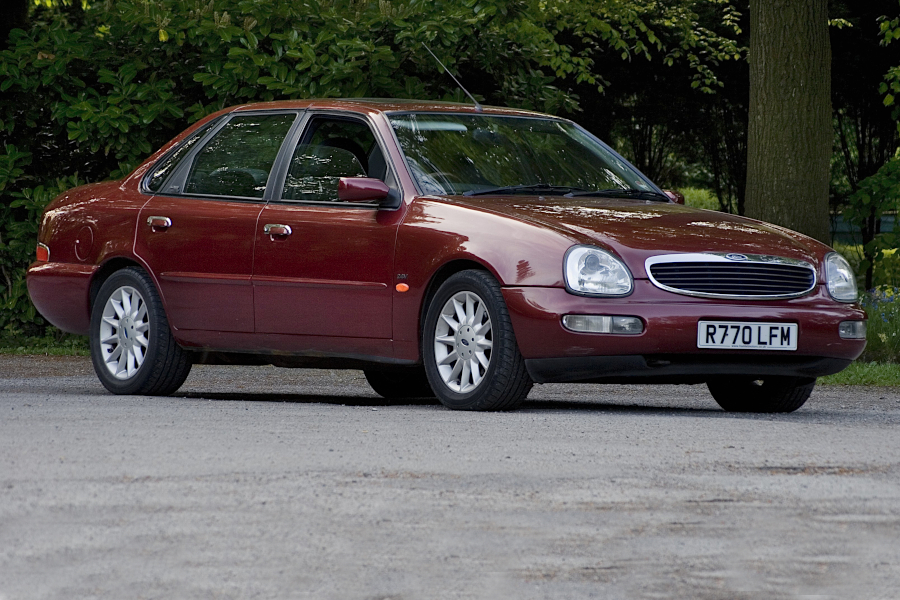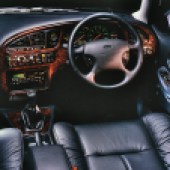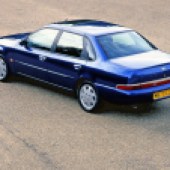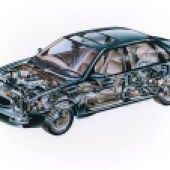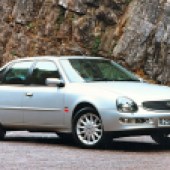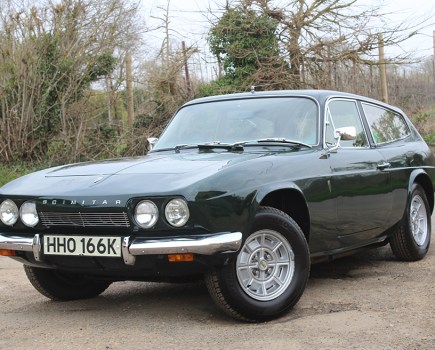We remember when the Blue Oval dropped the ball in the large car game with its last-ever executive saloon for Europe – the Ford Scorpio
Decorum and a general inscrutability are generally hallmarks of PR executives in blue chip companies and none more so than Ford Motor Company. Something which made the press launch of the Scorpio in 1994 notable as one of the rare occasions when the professional cloak slipped for just a moment. “No, no, I think you’ll find it’s a bold new design direction,” one of the PR men claimed deadpan… before dissolving into cackling laughter and heading for the bar.
To be fair, he probably needed a drink before trying to sell the Ford Scorpio to the world, for here was one of the Blue Oval’s biggest misjudgements – right up there with trying to market the Mk5 Escort before it was ready.
The issue, of course, was the styling. There’s a delightful urban rumour that nobody within Ford has yet publicly owned up to being responsible, but it was pretty universally condemned and indeed was so controversial that discussion of the car’s appearance inevitably tended to overshadow the other aspects of what was effectively a Mk4 Granada to us Brits.
Which was in fact a crying shame since under the oddball looks was a really credible car which offered performance, refinement and handling to rival the established premium players in the market – yet at a vastly lower price.
The Scorpio has its genesis in what seems like a different world to us today; one where buyers considering an entry-level Jaguar or Mercedes could also consider a better-value offering from the top end of a mainstream brand. For every breathless 518i, cloth-trimmed XJ6 or dreary E200, there was a Rover Sterling, Renault Safrane or the big Ford’s nemesis the Vauxhall Omega.
It was the Omega in particular which spurred Ford into replacing the Granada which although beloved by the buying public and the nation’s constabulary for its unique (in the D-segment) hatchback was obviously ageing.
The thorny issue for a company like Ford however was that compared to the massive sales volumes of Escorts and Fiestas the executive car segment was too small to justify massive investment. This explains why the Scorpio, although touted as an all-new development, was largely based on the previous Granada (confusingly already badged Scorpio outside the UK).
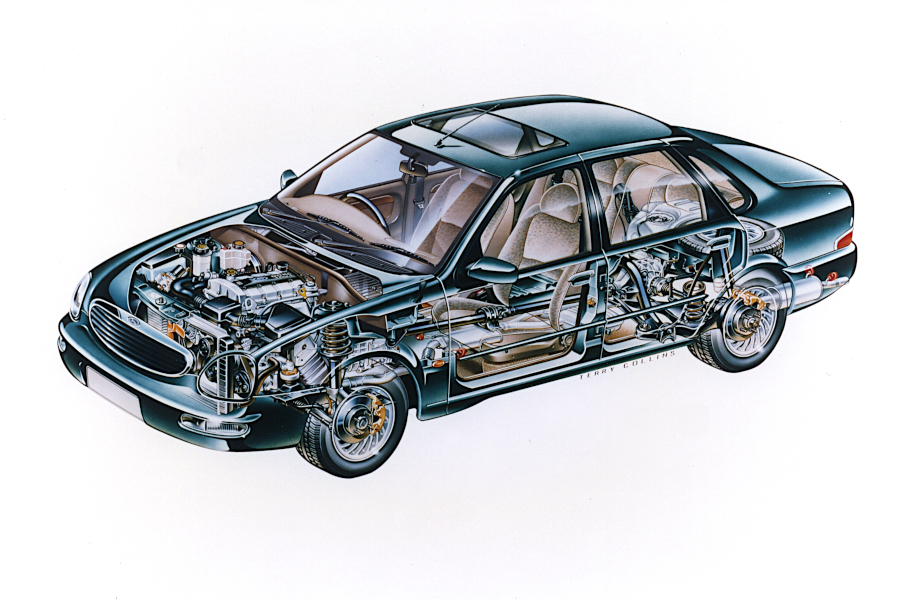
Technology
The older car’s platform was carried over, as was the engine and transmission line-up but a programme of determined detail improvements made a big difference to the end result – particularly in the areas of refinement and handling. Wings front and rear, bonnet and boot were all restyled, as were the door skins which now carried chrome door handles borrowed from the Crown Victoria.
The outgoing Granada had been known as a fine long-distance cruiser but was no driver’s car, especially in comparison to the 5-Series, tending to wallow and understeer noticeably when driven hard, with noticeable body roll. The suspension revisions aimed at countering this and were largely centred around front-end changes, using experience gained in developing the class-leading handling of the Mondeo. The Ford Scorpio retained the strut layout of the Granada, but added an A-shaped lower wishbone to provide improved lower location over the previous arrangement which used the anti-roll bar to control longitudinal movement of a narrow pressed-steel lower link. On the Scorpio the anti-roll bar was repositioned and located using drop links. The castor angle was increased by 58% to increase straight-line stability, while reducing the steering offset created a negative scrub radius providing a self-stabilising influence when braking on surfaces with unequal friction. A final touch was adding a fluid-filled bush for the rear mounting bush of the new lower front wishbone, which allowed sufficient rearward wheel movement to absorb potholes while still maintaining vertical movement.
At the rear, the BMW-style semi-trailing arm layout was retained, but the arms themselves were strengthened, as was the rear subframe, the net result being improved roll stiffness.
In combination with improvements to the bodyshell structure which improved its torsional rigidity, these changes lifted the appeal of the Scorpio massively and although it didn’t jump to the top of the class it went from dated to competitive, while also being as refined as anything else this side of the Jaguar.
I recall having the pinnacle of the Ford range on press loan for a week back in 1997, a Ford Scorpio saloon in 2.9 24V Ultima trim complete with the ‘FMC 1’ number plate and being surprised at what an improvement dynamically the car was over the Granada. And when you consider that my everyday car at the time was a BMW 5-Series that’s praise indeed.
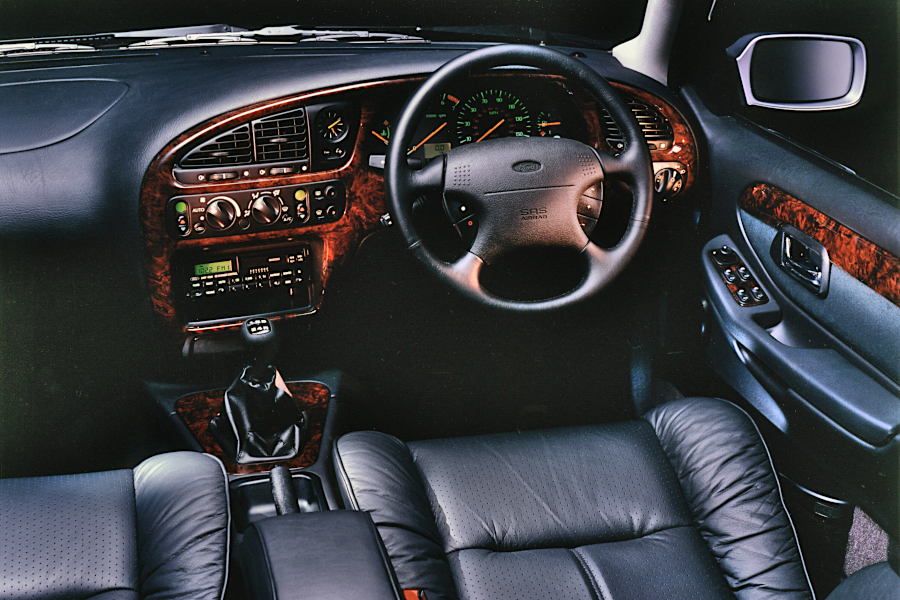
Top-flight powertrain was the long-serving ‘Cologne’ V6 engine in 2.9-litre flavour, with the Cosworth makeover introduced late in the previous car’s life which gave it an overhead-cam, 24-valve layout. Originally debuted in 1991 at 192bhp, the Cosworth motor was given a variable-length inlet tract for the Scorpio, together with revised cams and valve springs, all controlled by Ford’s new EEC-V engine management system which took power to 204bhp with 207lb.ft torque. The range-topping engine was offered only with the four-speed automatic, Ford’s own A4LDE unit which gained electronic rather than hydraulic control to provide faster and smoother shifts as well as ‘sport’ and ‘winter’ modes.
The V6 was also offered in its older 12-valve format rated at 145bhp, with an entry-level offering provided by the 134bhp 16-valve derivative of the evergreen Pinto engine known as ‘DOHC’ in Ford circles. A diesel option meanwhile was provided courtesy of Italian maker VM in the shape of a 2.5-litre four-banger rated at a meagre 113bhp.
In 1996, the range was broadened with the addition of the eight-valve version of the 114bhp 2-litre DOHC engine as well as a new 145bhp 2.3-litre variant, while the VM diesel was revised in 1997 to meet new emissions regulations and uprated to 125bhp.
In truth, both 2-litre engines were a touch underwhelming in the big Ford, while the VM diesel fell some way short of the competition – notably the six-cylinder BMW diesel also offered in the Omega – which made the sensible choice either the 2.3-litre DOHC or the 24-valve V6.
The smooth-revving and muscular Cosworth motor did make the Granada something of a Q-car and in top-level Ultima trim made it a credible contender to the likes of the Rover and Vauxhall, even if the Jaguar did have the edge on handling. For those who found the 15mpg of the V6 just too uncomfortable, the 2.3-litre DOHC was the perfect compromise and on the road it was the equal of the 12-valve V6 if not the twin-cam Cosworth version. For a four-cylinder of this capacity it’s also acceptably smooth thanks to the use of twin balancer shafts and although only introduced late in the Scorpio’s life, the 2.3 quickly became the bigger seller.
Although the Granada’s hatchback layout had been abandoned for the Scorpio, the estate was retained, and the decision to carry over the rear-end styling of the older car must have won a handy number of sales to customers who could handle the fish-faced front but just couldn’t stomach the droopy rear with its chrome strip and awkward detailing.
And here we go again, getting sidetracked by the styling. In fairness to Ford, it realised pretty early on that the car’s looks were killing it in the marketplace and in November 1997 unveiled a facelifted version.
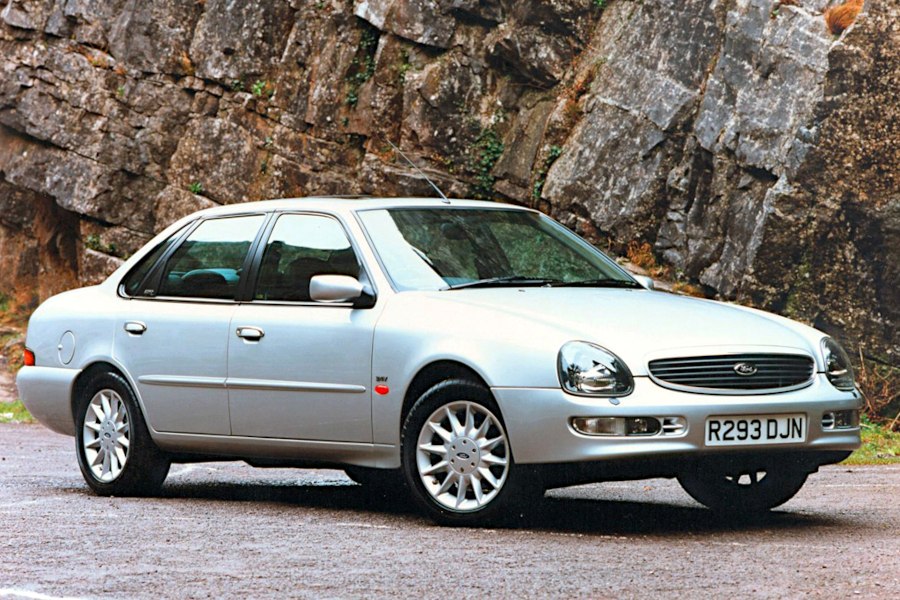
Facelift
The Ford Scorpio’s headlights gained a dark inner housing and a colour-coded grille together with a revised front bumper, while the rear end was more significantly revised with a new bootlid pressing to reduce the bulbous shape.
Sadly, it was all too late and Ford pulled the plug on the car in June 1998, leaving the gap to be filled by V6-engined Ghia X-specced Mondeos. Total Ford Scorpio production amounted to 98,587 which by Ford standards probably stands as a monumental failure, matching as it does almost exactly the 92,038 total of Jaguar’s ‘X300’ XJ produced in almost exactly the same time frame.
But don’t shed too many tears for the men round the Dearborn board table: by then Ford had Volvo and Jaguar as its contenders in the executive segment.

